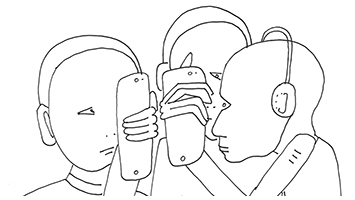1.mov.Still002_s.jpg)
1.mov.Still002_s.jpg)
7×7×7 秒
7×7×7 seconds
2016,單頻錄像,5分43秒
Single-channel video, 5'43"
大衛・布蘭迪
David BLANDY
英國 1976年生於倫敦,現於布萊頓與倫敦生活及工作
UK 1976 born in London, now living and working in Brighton and London
《7 x 7 x 7 秒》為英國藝術家大衛布蘭迪於2016年的單頻道影像作品,網路搜集的影像以七角星形的型式羅列展現了自古以來所有人類發展出和數字7相關的知識學問。作品一路訴說著數字7的歷史伴隨著第七和弦的音樂與七拍子的節奏,內容自天體宇宙、人體生理結構、生物與物質的共同特徵,再至更為形而上屬為人為創造的規則與創作。
在藝術家的說法中提及,人類有為事物找到規則的原始欲望,更甚於因此相信偶然是某種陰謀論帶來的結果,而隨機是由更高層次看不見的力量所佈局的事件。作品中大衛經由成串的重覆的列舉與荒謬而全面的範例組合,影像建築了一個關於7的力量迷思,爾後又在種種影像的加速度與失去方向的旋轉下,迷思的效力隨著影像的難以區辨漸漸被削弱,抽象地創造出一種介於事實與幻想中的衝突感,提問了有關於「知識建構」的概念及本質。
再進一步的思考,或許我們可以說,當訊息被賦予意義後會成為資訊,而資訊在經過整理歸納後會成為知識。又或者,我們可以說知識是我們的思想產物,經過我們的思考方法來面對當前的問題。無論是何者,在大數據的時代中,也許我們該剝除數據的計算與意義,駕馭訊息的變化,從演算中脫身進而重新面對並理解問題的本身,重新識別、定義問題,也許也是在隱藏於大衛的作品中關於規則與建構的隱性提問。
7x7x7 seconds is a single-channel video work by British artist David Blandy in 2016 with images found on the Internet laid out in the form of seven-pointed start shape to demonstrate all the knowledge developed by Mankind related to number 7. The work tells the history of number 7, accompanied by the music of the 7 chord and the tempo of 7 beats, from the Cosmos, the physiological structure of humans, and the common features of living creature and matter, to more meta-physical, man-made rules and creations.
According to the artist, humans possess the primitive desire to search for the rules for things. It is more than believing accidents are the result of some conspiracy and that randomness is an incident laid out by a higher power invisible to us. In the work, David comes up with a comprehensive model combination through series of repeated enumeration. Images construct a myth of 7's power. Later, amidst images’ acceleration and disoriented rotation, the power of myth is gradually weaken as the images become more and more indistinguishable, abstractly creating a sense of conflict between fact and fantasy as well as inquiring the concept and nature of “knowledge construct”.
Taking it further, perhaps it is safe for us to say that when a message is given meaning, it becomes information, and information becomes knowledge after organization. Furthermore, we can also say knowledge is the product of our mind in the face of the current issues through our way of thinking. Either way, in the age of big data, perhaps we should stripe off the calculation and meaning of data and harness the change of messages, free from the algorithm before facing once again and understanding the question itself, in order to re-identify and redefine questions. It is perhaps the recessive inquiry about rules and construct hidden in David’s work as well.







